Apps
Auto Added by WPeMatico
Auto Added by WPeMatico
Rovio’s efforts to diversify beyond its Angry Birds franchise is getting a little investment boost today. The company announced that Japan’s NTT Docomo is taking a stake in Hatch, a Rovio subsidiary that describes itself as the “Netflix of gaming,” providing subscribers with a rotating mix of freemium games from a mix of publishers, with the option of paying a single monthly fee for a wider mix.
Docomo and Rovio are not discussing the size or value of the stake, but a spokesperson for Rovio told TechCrunch that prior to this deal, Hatch was 80 percent owned by Rovio and 20 percent by Hatch personnel. He didn’t specify who had sold shares to Docomo in this latest transaction.
The deal will cover not just investment to expand the Hatch platform and number of games on offer — currently the selection numbers more than 100 — but to bring Hatch specifically to the Japanese market.
This will include, starting next week (February 13), a soft launch of Hatch on Android devices in the country, as well as prominent placement of Hatch on Docomo’s Android TV service, sweetening the deal with three-month free trials of the Premium tier.
The Android TV offering is a key OTT play for Docomo. Known primarily as one of the country’s biggest mobile carriers (and, historically, a trailblazer in mobile services, setting the pace for how much was building in the world of mobile content globally in the earliest days of mobile phones), like other network service providers, Docomo has been hit hard by the huge wave of services that bypass carriers and strike billing deals directly with consumers.
Hatch will be one more feather in Docomo’s cap to try to lure more people to its service, which can be subscribed to and paid for by way of Docomo’s “d Account,” an iTunes-style platform that people can use regardless of which network carrier they contract with.
Like Netflix, Amazon and other OTT video streaming plays, the concept behind Hatch is to offer a mix of games from various publishers, as well as developing its own selection of games in-house that it hopes will be popular enough to help differentiate the service from the rest of the field.
That is critical, because Hatch and Rovio are not the only ones vying for the title of “Netflix for gaming.” Other formidable hopefuls include Amazon, Microsoft, Apple, Google and perhaps maybe even Netflix itself.
The current selection of games on Hatch include Monument Valley, Space Invaders Infinity Gene and Hitman GO, with a new game called Arkanoid Rising — “a bold new reimagining of the arcade classic produced in association with Japanese gaming legends TAITO” — coming in the spring, which will be “the first Hatch Original exclusive to the platform.”
Down the line, there also will be collaborations to develop esports events and more titles, Rovio said.
The move is a natural one for Hatch, given gaming culture and how strong it is in Japan.
“Japan is the world’s third largest games market and where the video games industry as we know it was born. In this extremely competitive market we couldn’t be happier to work with a partner like Docomo to help take our vision of cloud gaming mainstream,” says Juhani Honkala, Hatch founder and CEO, in a statement. “Docomo’s leading contributions to 5G technology and infrastructure and commitment to amazing new 5G-enabled services make the company an ideal strategic partner in Japan, and we look forward to a long and fruitful collaboration.”
“We are excited to work together with Hatch, a great example of the new type of consumer services, which can bring out its potential towards the 5G era,” added Takanori Ashikawa, director, Consumer Business Department of Docomo, in a separate statement. “Hatch’s vision for cloud gaming changes the way people play and discover games, and our shared goal to enrich the everyday lives of our customers makes Hatch an excellent strategic partner for the long term.”
Since its lacklustre public debut in September 2017, Rovio has been facing a lot of growth challenges, in part because of strong competition in the gaming industry and the company’s over-reliance on a nearly 10-year-old franchise amid a bigger industry shift to new tastes in games — marked by the rise of streamed, multiplayer titles like Fortnite.
But while overall profits have continued to decline at the company, sales of some titles have actually grown, with Angry Birds 2 — now almost three years old — surprisingly seeing a surge of growth in 2018.
In that context, a different focus by way of Hatch, with a little financial help from NTT Docomo, could be the bet that helps catapult Rovio to a new level of the gaming playing field.
Powered by WPeMatico
Snap has finally begun publicly testing the engineering overhaul of its slow and buggy Android app that for years has cost Snapchat users. Promising early results and reduction in app startup time could help Snapchat fix its growth problem after daily active users sank in Q2 and Q3 before staying put at 186 million in Q4, Snap announced in its earnings report today.
“We ended the year with user engagement stabilizing and have started rolling out the new version of our Android application to a small percentage of our community,” CEO Evan Spiegel wrote. “Early tests show promising results especially on less performant devices, including a 20 percent reduction in the average time it takes to open Snapchat.” The problem is that because “Our engineering team remains focused on rebuilding our Android application,” they haven’t been dedicated to fixing the existing version. That means that despite iOS daily active users and average time spent growing faster than last year, Android dragged Snapchat again to see no total daily user growth.
Interim Chief Financial Officer Lara Sweet noted that, “While we are not going to give specific guidance on daily active users, we are cautiously optimistic and we do not foresee a sequential decline in daily active users in Q1 2019.” It seems Snap believes the new year is going well and the Android rollout could stem losses so it might finally grow its user count again, or at least stop shrinking.
Powered by WPeMatico
Reddit is raising $150 million to $300 million to keep the front page of the internet running, multiple sources tell TechCrunch. The forthcoming Series D round is said to be led by Chinese tech giant Tencent at a $2.7 billion pre-money valuation. Depending on how much follow-on cash Reddit drums up from Silicon Valley investors and beyond, its post-money valuation could reach an epic $3 billion.
As more people seek esoteric community and off-kilter entertainment online, Reddit continues to grow its link-sharing forums. Indeed, 330 million monthly active users now frequent its 150,000 Subreddits. That warrants the boost to its valuation, which previously reached $1.8 billion when it raised $200 million in July 2017. As of then, Reddit’s majority stake was still held by publisher Conde Nast, which bought in back in 2006 just a year after the site launched. Reddit had raised $250 million previously, so the new round will push it to $400 million to $550 million in total funding.
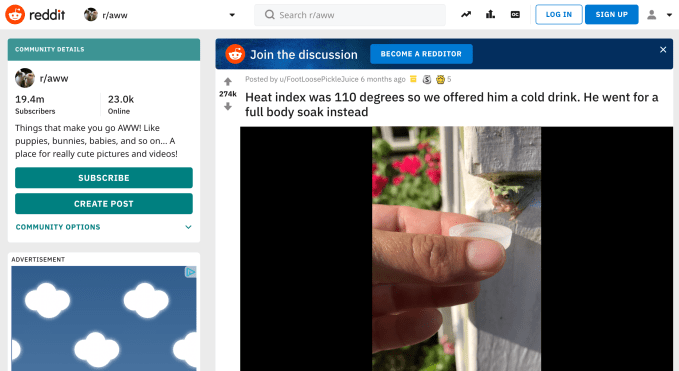
It should have been clear that Reddit was on the prowl after a month of pitching its growth to the press and beating its own drum. In December Reddit announced it had reached 1.4 billion video views per month, up a staggering 40 percent from just two months earlier after first launching a native video player in August 2017. And it made a big deal out of starting to sell cost-per-click ads in addition to promoted posts, cost per impression and video ads. A 22 percent increase in engagement and 30 percent rise in total view in 2018 pushed it past $100 million in revenue for the year, CNBC reported.
The exact details of the Series D could fluctuate before it’s formally announced, and Reddit and Tencent declined to comment. But supporting and moderating all that content isn’t cheap. The company had 350 employees just under a year ago, and is headquartered in pricey San Francisco — though in one of its cheaper but troubled neighborhoods. Until Reddit’s newer ad products rev up, it’s still relying on venture capital.
Tencent’s money will give Reddit time to hit its stride. It’s said to be kicking in the first $150 million of the round. The Chinese conglomerate owns all-in-one messaging app WeChat and is the biggest gaming company in the world thanks to ownership of League of Legends and stakes in Clash of Clans-maker Supercell and Fortnite developer Epic. But China’s crackdown on gaming addiction has been rough for Tencent’s valuation and Chinese competitor ByteDance’s news reader app Toutiao has grown enormous. Both of those facts make investing in American newsboard Reddit a savvy diversification, even if Reddit isn’t accessible in China.
Reddit could seek to fill out its round with up to $150 million in additional cash from previous investors like Sequoia, Andreessen Horowitz, Y Combinator or YC’s president Sam Altman. They could see potential in one of the web’s most unique and internet-native content communities. Reddit is where the real world is hashed out and laughed about by a tech-savvy audience that often produces memes that cross over into mainstream culture. And with all those amateur curators toiling away for internet points, casual users are flocking in for an edgier look at what will be the center of attention tomorrow.

Reddit has recently avoided much of the backlash hitting fellow social site Facebook, despite having to remove 1,000 Russian trolls pushing political propaganda. But in the past, the anonymous site has had plenty of problems with racist, misogynistic and homophobic content. In 2015 it finally implemented quarantines and shut down some of the most offensive Subreddits. But harassment by users contributed to the departure of CEO Ellen Pao, who was replaced by Steve Huffman, Reddit’s co-founder. Huffman went on to abuse that power, secretly editing some user comments on Reddit to frame them for insulting the heads of their own Subreddits. He escaped the debacle with a slap on the wrist and an apology, claiming “I spent my formative years as a young troll on the Internet.”
Investors will have to hope Huffman has the composure to lead Reddit as it inevitably encounters more scrutiny as its valuation scales up. Its policy choice about what constitutes hate speech and harassment, its own company culture and its influence on public opinion will all come under the microscope. Reddit has the potential to give a voice to great ideas at a time when flashy visuals rule the web. And as local journalism wanes, the site’s breed of vigilante web sleuths could be more in demand, for better or worse. But that all hinges on Reddit defining clear, consistent, empathetic policy that will help it surf atop the sewage swirling around the internet.
Powered by WPeMatico
The Daily Crunch is TechCrunch’s roundup of our biggest and most important stories. If you’d like to get this delivered to your inbox every day at around 9am Pacific, you can subscribe here:
1. Facebook now lets everyone unsend messages for 10 minutes
For up to 10 minutes after sending a Facebook Message, the sender can tap on it and they’ll find the delete button has been replaced by “Remove for you” and “Remove for everyone” options. If you select the latter, recipients will see an alert saying that you removed a message, and they can still flag the message.
The feature could come in handy in those moments when you realize, right after hitting send, that you’ve made an embarrassing typo or said something dumb. It won’t, however, let people change ancient history.
2. Alphabet revenues are up 22% but the stock is still dropping
The company’s beat of analyst estimates would have been a miss if not for a $1.3 billion unrealized gain “related to a non-marketable debt security.”
3. Toyota’s new car subscription company Kinto is gamifying driving behavior
Toyota has officially launched Kinto, a company first revealed late last year that will manage a car subscription program and other mobility services in Japan, including the sale and purchase of used vehicles as well as automotive repair and inspection.

4. Apple pays millions in backdated taxes to French authorities
“The French tax administration recently concluded a multi-year audit on the company’s French accounts, and those details will be published in our public accounts,” the company told Reuters. French authorities can’t confirm the transaction due to tax secrecy.
5. Self-driving truck startup Ike raises $52 million
The startup was founded by veterans of Apple and Google, as well as Uber Advanced Technologies Group’s self-driving truck program. Its mission — expand and deploy — sounds a lot like other autonomous vehicle startups, but that’s where the parallels end.
6. Facebook bans four armed groups in Myanmar
Facebook has introduced new security features and announced plans to increase its team of Burmese language content translators to 100 people. While it doesn’t intend to open an office in Myanmar, it has ramped up its efforts to expel bad actors.
According to co-founder Nayeem Islam, Blue Hexagon has created a real-time, cybersecurity platform that he says can detect known and unknown threats at first encounter, then block them in “sub seconds” so the malware doesn’t have time to spread.
Powered by WPeMatico
Apple released a new beta version of iOS 12.2 yesterday. While the final version isn’t available just yet, here’s what you should expect: new Animojis and a fake 5G logo if you’re an AT&T customer.
If you have an iPhone X, XS, XS Max or XR, you’ll see new animals in the Animoji collection. As 9to5mac spotted, you will be able to record a video message and replace your head with a giraffe, an owl, a shark or a warthog. These Animojis will also work during FaceTime calls.
Here’s a picture from 9to5mac with the new lineup:
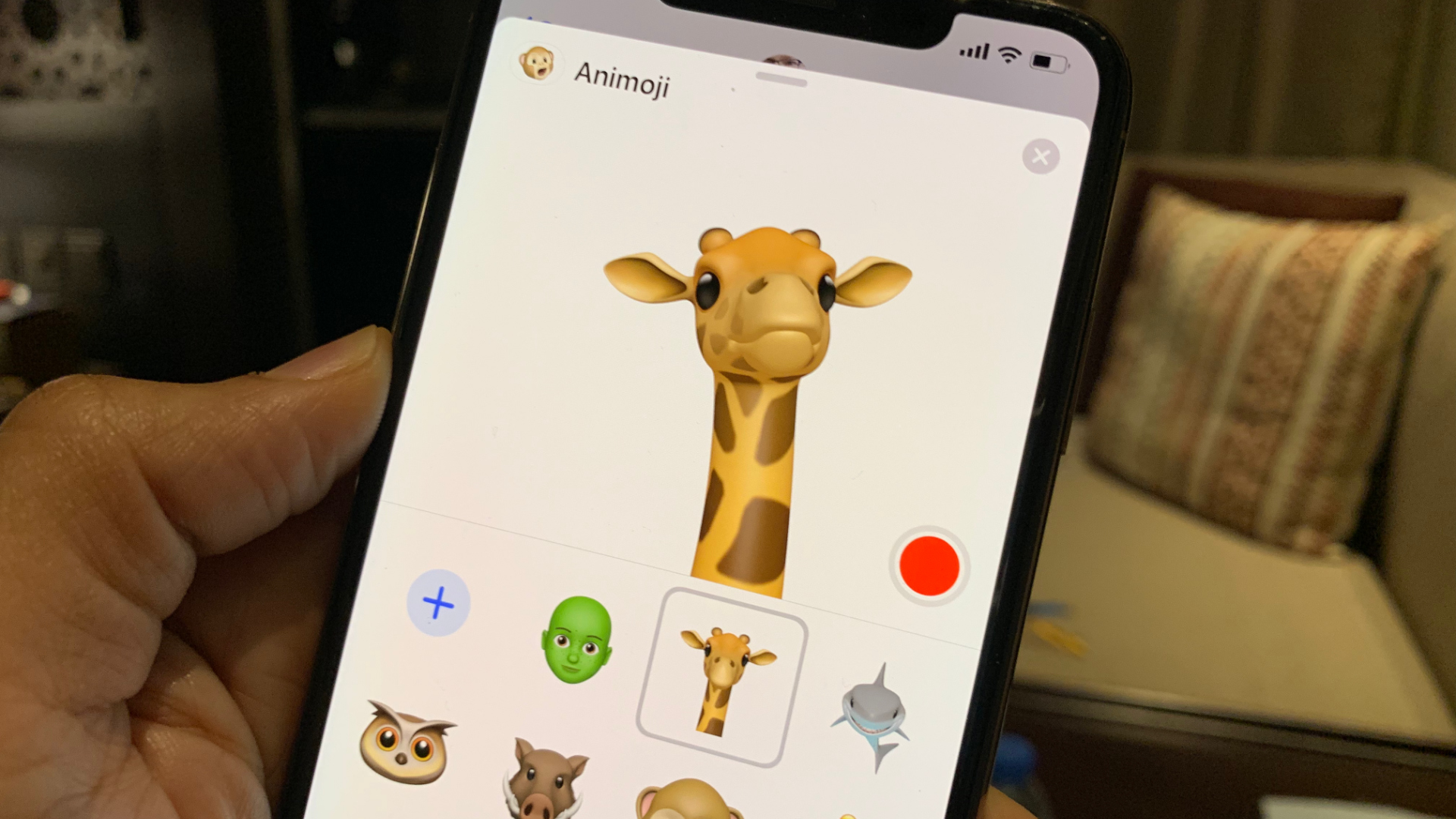
More interestingly, Apple succumbed to AT&T’s marketing plot to rename 4G to 5G. MacRumors noticed that some AT&T users now have a “5G E” icon in the top-right corner when they upgrade to the beta version of iOS 12.2. Some Android phones already show a 5G E icon after an AT&T update.
But don’t get fooled, this isn’t 5G — this icon replaces the LTE icon. AT&T has basically rebranded LTE with carrier aggregation as 5G Evolution. But it still runs on the same network.
Here’s a picture from the MacRumors forums:
![]()
The same thing happened in the U.S. during the transition from 3G to 4G. AT&T decided to rebrand its 3G HSPA+ network to 4G. It’s the reason why many carriers talk about LTE instead of 4G.
AT&T confused everyone back then, and the company is about to do the same again. It’s too bad Apple is helping AT&T with this iOS update.
Disclosure: TechCrunch is a Verizon Media company.
Powered by WPeMatico
Facebook has finally made good on its promise to let users unsend chats after TechCrunch discovered Mark Zuckerberg had secretly retracted some of his Facebook Messages from recipients. Today Facebook Messenger globally rolls out “Remove for everyone” to help you pull back typos, poor choices, embarrassing thoughts or any other message.
For up to 10 minutes after sending a Facebook Message, the sender can tap on it and they’ll find the delete button has been replaced by “Remove for you,” but there’s now also a “Remove for everyone” option that pulls the message from recipients’ inboxes. They’ll see an alert that you removed a message in its place, and can still flag the message to Facebook, which will retain the content briefly to see if it’s reported. The feature could make people more comfortable having honest conversations or using Messenger for flirting since they can second-guess what they send, but it won’t let people change ancient history.
The company abused its power by altering the history of Zuckerberg’s Facebook’s messages in a way that email or other communication mediums wouldn’t allow. Yet Facebook refused to say if it will now resume removing executives’ messages from recipients even long after they’re delivered after telling TechCrunch in April that “until this feature is ready, we will no longer be deleting any executives’ messages.”
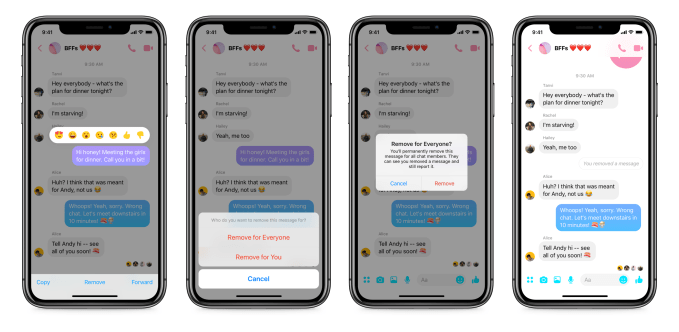
For a quick recap, here’s how Facebook got to Unsend:
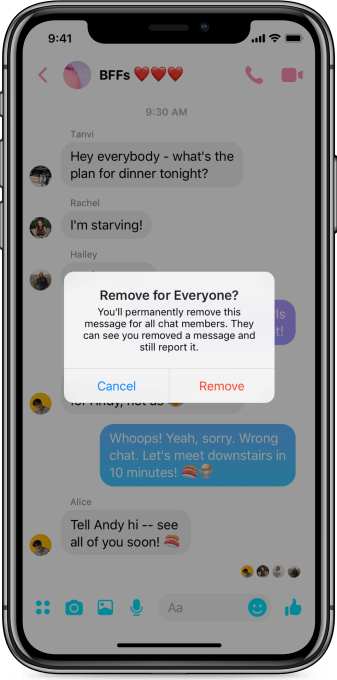 -Facebook Messenger never had an Unsend option, except in its encrypted Secret messaging product where you can set an expiration timer on chats, or in Instagram Direct.
-Facebook Messenger never had an Unsend option, except in its encrypted Secret messaging product where you can set an expiration timer on chats, or in Instagram Direct.
-In April 2018, TechCrunch reported that some of Mark Zuckerberg’s messages had been removed from the inboxes of recipients, including non-employees. There was no trace of the chats in the message thread, leaving his conversation partners looking like they were talking to themselves, but email receipts proved the messages had been sent but later disappeared.
-Facebook claimed this was partly because it was “limiting the retention period for Mark’s messages” for security purposes in the wake of the Sony Pictures hack, yet it never explained why only some messages to some people had been removed.
-The next morning, Facebook changed its tune and announced it’d build an Unsend button for everyone, providing this statement: “We have discussed this feature several times . . . We will now be making a broader delete message feature available. This may take some time. And until this feature is ready, we will no longer be deleting any executives’ messages. We should have done this sooner — and we’re sorry that we did not.”
-Six months later in October 2018, Facebook still hadn’t launched Unsend, but then TechCrunch found Facebook had been prototyping the feature.
-In November, Facebook started to roll out the feature with the current “Remove for everyone” design and 10-minute limit.
-Now every iOS and Messenger user globally will get the Unsend feature.
So will Facebook start retracting executives’ messages again? It’d only say that the new feature would be available to both users and employees. But in Zuckerberg’s case, messages from years ago were removed in a way users still aren’t allowed to. Remove for everyone could make messaging on Facebook a little less anxiety-inducing. But it shouldn’t have taken Facebook being caught stealing from the inboxes of its users to get it built.
Powered by WPeMatico
BetterCloud began life as a way to provide an operations layer for G Suite. More recently, after a platform overhaul, it began layering on a handful of other SaaS applications. Today, the company announced, it is now possible to add any SaaS application to its operations dashboard and monitor usage across applications via an API.
As founder and CEO David Politis explains, a tool like Okta provides a way to authenticate your SaaS app, but once an employee starts using it, BetterCloud gives you visibility into how it’s being used.
“The first order problem was identity, the access, the connections. What we’re doing is we’re solving the second order problem, which is the interactions,” Politis explained. In his view, companies lack the ability to monitor and understand the interactions going on across SaaS applications, as people interact and share information, inside and outside the organization. BetterCloud has been designed to give IT control and security over what is occurring in their environment, he explained.
He says they can provide as much or as little control as a company needs, and they can set controls by application or across a number of applications without actually changing the user’s experience. They do this through a scripting library. BetterCloud comes with a number of scripts and provides log access to give visibility into the scripting activity.
If a customer is looking to use this data more effectively, the solution includes a Graph API for ingesting data and seeing the connections across the data that BetterCloud is collecting. Customers can also set event triggers or actions based on the data being collected as certain conditions are met.
All of this is possible because the company overhauled the platform last year to allow BetterCloud to move beyond G Suite and plug other SaaS applications into it. Today’s announcement is the ultimate manifestation of that capability. Instead of BetterCloud building the connectors, it’s providing an API to let its customers do it.
The company was founded in 2011 and has raised more than $106 million, according to Crunchbase.
Powered by WPeMatico
Coda, which is coming out of its limited beta today, wants to reinvent how you think about documents and spreadsheets. That’s about as tough a challenge as you can set yourself, given how ingrained tools like Word, Excel and their equivalents from the likes of Google, Zoho and others are. Coda’s secret weapon is that it combines text and spreadsheet functionality into a single document, with the ability to build some basic programming into them and add features from third-party services as a bonus.
In addition to opening up the service to anyone, Coda also today launched its new mobile app for iOS (with Android following at some point in the future).
“It’s the best of documents, spreadsheets, presentations, applications — all brought into one new surface,” Coda founder and CEO (and former head of product for YouTube Shishir Mehrotra told me. “But the phrase we like to use is that Coda allows anyone to make a doc as powerful as an app.”
You’re not going to use Coda, which was founded in 2017 and received funding from VC heavyweights like Greylock, Khosla Ventures and NEA, as a full-blown low code/no code service. It’s still a bit too limited for that. But you can use it to build your own custom inventory system, for example, or to build a basic CRM or to-do app that fits your specific needs. Or you could just use it as an online text editor and then slowly add features like third-party integrations with the likes of Slack or Figma as needed. All of that is easy enough for anybody who has ever used a function in Excel or Google Sheets.
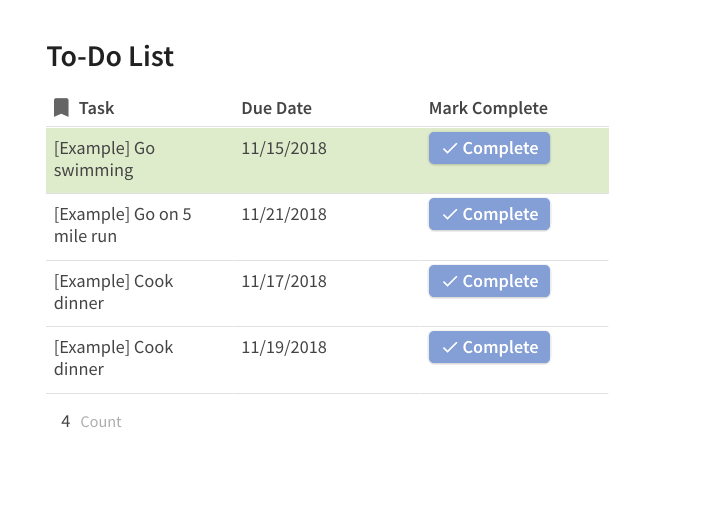
So far, tens of thousands of people have used the service during its private beta. Mehrotra tells me that about 15 percent of them are from the Bay Area and that a good amount of them simply use the service as a basic document editor.
The new iOS app, unsurprisingly, mostly focuses on consuming content and using the functions that you have built in the web app. It’s unlikely that you’ll want to build a whole new experience on your phone, after all. In the demos I’ve seen, Coda nicely transforms cells and their functions into usable tables and cards on the iPhone.
Powered by WPeMatico
Teens’ aversion to Facebook jeopardizes not only the company’s feed ad revenue, but its dominance as an identity provider. The Facebook Login platform keeps people tied to the social network in order to easily access other apps without a separate username and password. But for younger users who ditch or neglect Facebook in favor of Instagram, the tech giant stands to lose one of its most powerful wedges into our lives. Meanwhile, Instagram loyalists are forced to juggle multiple sets of login credentials to manage their personal, Finsta and business accounts.
But a new feature in development could make it easy to operate multiple Instagram handles while poising the app as a successor to Facebook Login. Instagram has prototyped the “Main Account” feature that would let users set one of their profiles as a primary account and then link their other accounts to it. Logging into the main account would instantly log them in to the rest, as well. From then on, users would only need to remember a single email/username and password combo. Simpler login could get people switching accounts, posting and engaging more with Instagram.

Account linking could also power up Instagram’s existing login platform. Currently, third-party apps use it to let you compose feed posts and Stories and then share them to Instagram, or to measure the activity and mentions of business accounts. But Instagram could potentially expand the login platform to let you bring more of your identity or profile info to other apps similar to Facebook Login. That might work better if you could log in through your main Instagram account and then choose which profile you wanted to use or share back to from another app.
TechCrunch was tipped off to code for “Account Linking” in the Instagram for Android alpha version’s APK files by social media researcher Ishan Agarwal. The code explains “Quickly and securely log in to all of your Instagram accounts with one ID and password . . . Make one of your accounts your main account and use it to log in to all of your other accounts at once . . . Your accounts will remain separate but logging in will be fast and simple . . . Anyone who has the password for your main account will have access to the accounts connected to it.”
Instagram declined to comment regarding the feature. That’s standard for the company when it has prototyped something it is trying out with employees but hasn’t done any external testing. But many features first spotted in the app’s code at this stage go on to be fully rolled out, like Instagram video calling, nametags and soundtracks.
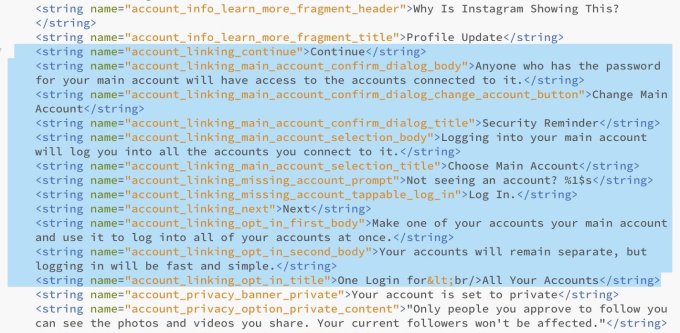
Facebook colonized the web using its login platform, scattering buttons with its logo on sites as an alternative to having to create a new account for every service. This helped grow Facebook’s user base, lock in users so it’d be harder for them to deactivate, develop new sources of feed content and gather data on what people did around the web. Many users who’ve stopped heavily posting to or reading Facebook still maintain a connection with the social network because they rely on it to log in to Spotify, Netflix and other services.
In fact, Facebook’s login platform is one of its most valuable features, where it lacks strong competition. Google runs its own identity platform, but with people increasingly using two-factor authentication and other security to protect their Gmail accounts, it can sometimes be a bit clumsy. Snapchat is trying to build up its own Snap Kit login platform with partners like Poshmark, but few mainstream apps have implemented it for account creation.

Instagram has been tinkering with other features around the concept of identity. It launched Close Friends for sharing Stories just with your besties, rolled out its own two-factor authentication option and is adding a way to syndicate your feed posts to multiple accounts you control. Getting users to establish a main account could also smooth Facebook’s plan to offer encrypted cross-app messaging between itself, Instagram and WhatsApp. Your main account might be a stand-in for your real identity as Instagram doesn’t force a real-name policy on users like Facebook does.
If you start to think of Instagram as not just a parallel social network to Facebook but as either an escape pod or heir to the throne, it’s important to consider how Facebook’s core assets will weather the transition. Recent profile redesigns have already tried to make your Instagram profile the center of your online personality. Uniting the prismatic shards of your identity through account linking could let you carry that personality with you across the web.
Powered by WPeMatico
YouTube is expanding the test of its “Explore” feature, a new discovery tool it first introduced as an experiment within its iPhone app last year. Similar to Instagram’s Explore page, the new YouTube feature aims to introduce users to a diverse set of personalized recommendations so they can more easily find something new to watch. The test is now available across devices, and has been updated to also suggest smaller, up-and-coming YouTube creators, the company says.
The changes to Explore were announced in a recent Creator Insiders video, where the company shares ideas it’s thinking about or testing ahead of a public debut — like a change to the “dislike” button, for example.
Last year, the company published a video to Creator Insiders where it talked about a plan to develop a new place within the YouTube app that would help people broaden their horizons when looking for something different to watch.
Today, YouTube’s recommendation technology relies heavily on past viewing activity and other in-app behavior to make its content suggestions, the company explained. With the Explore tab, however, YouTube aims to widen recommendations to include various topics, videos and channels you may not have otherwise encountered.
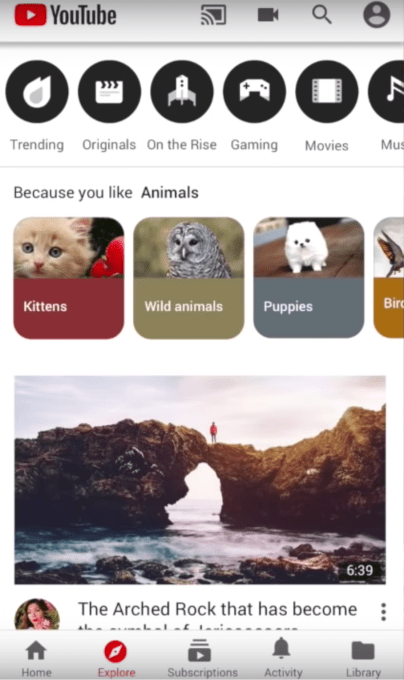
For instance, the Explore section might recommend videos about high-end cameras after you watched videos about telescopes. Or it might recommend videos about kittens or puppies because you watched other animal videos.
When YouTube launched Explore last year, the test was only rolled out to 1 percent of YouTube’s iPhone app users.
On testers’ devices, Explore replaces the Trending tab in the app’s navigation at the bottom of the screen. The section of Trending videos then became just another sub-category within Explore, alongside other top-level sections like Gaming, Movies, Music, Originals and more.
While Explore was initially available only to iPhone users, the test has now gone live across devices, including iPhones, iPads, Android phones and tablets and on the desktop, YouTube confirmed to TechCrunch. But it’s still only available to a “small amount” of testers, the company says.
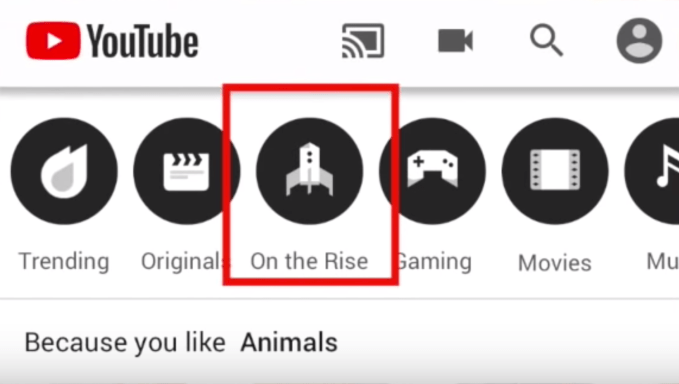
In addition, Explore has been updated to include a new section called “On the Rise,” which will feature up-and-coming YouTube creators.
Here, a shelf is shown showcasing creators with fewer than 10,000 subscribers. These suggestions are personalized to you, too, based on which channels you currently like and regularly watch.
Beneath the “Under 10K” section are other creators YouTube thinks you’ll like, based on your YouTube watch history as well as those whose channels are watched by other fans of your favorite creators.
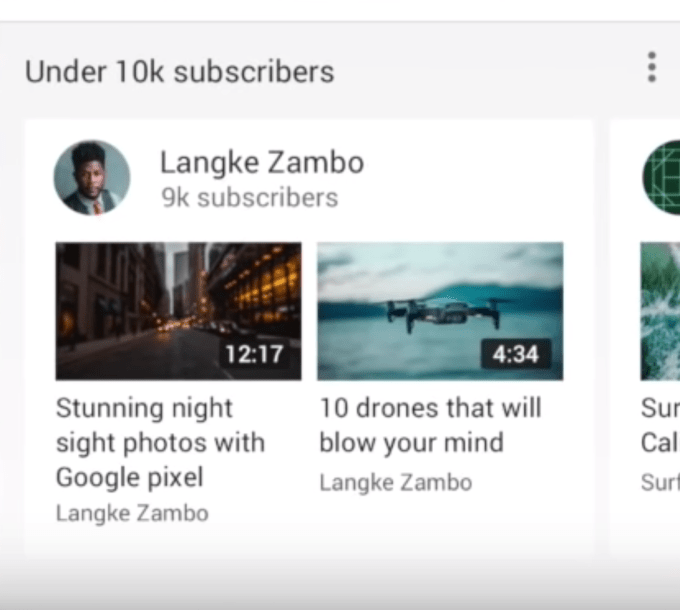
These recommendations may include those channels with more than 10,000 subscribers, but there will be a cap on how many subscribers a creator can have to be categorized within this “On the Rise” section. (That cap is still TBD, though.)
We understand that while YouTube has expanded the experiment’s reach, it doesn’t yet have a definitive plan for rolling out to the public the Explore tab.
For now, Explore is still considered an experiment and the company is looking to gather more feedback before making a formal decision about the feature’s wider availability.
Powered by WPeMatico